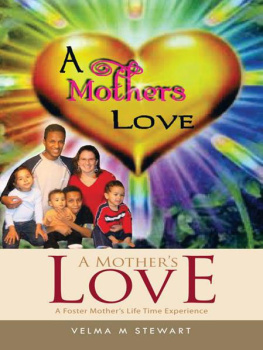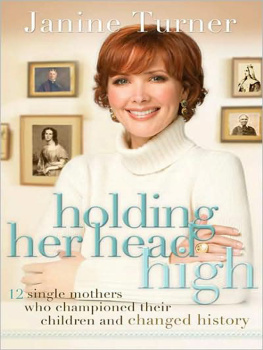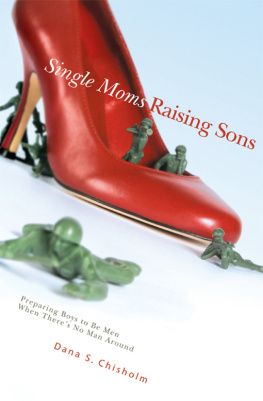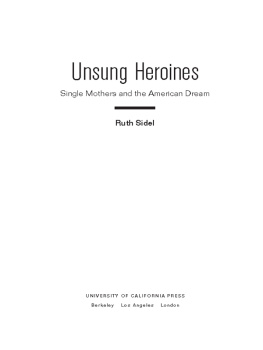The University of Chicago Press, Chicago 60637
The University of Chicago Press, Ltd., London
1993 by The University of Chicago
All rights reserved. Published 1993
Paperback edition 1994
Printed in the United States of America
02 01 00 99 98 97 96 4 5 6
ISBN: 978-0-226-21964-6 (ebook)
ISBN (cloth): 0-226-67183-6
ISBN (paperback): 0-226-67184-4
Part of appeared as Deconstructing the Discourse of Care: Young Children in the Shadows of Democracy, 1992 by The University of Chicago, in Reconceptualizing the Early Childhood Curriculum, edited by Shirley A. Kessler and Beth Blue Swadener (New York: Teachers College Press, 1992).
Library of Congress Cataloging-in-Publication Data
Polakow, Valerie.
Lives on the edge: single mothers and their children in the other America / Valerie Polakow.
p. cm.
Includes bibliographical references and index.
1. Single mothersUnited States. 2. Poor womenUnited States. 3. Poor childrenUnited States. I. Title.
HQ759.45.P66 1993
306.85'6'0973dc20
92-21977
CIP

The paper used in this publication meets the minimum requirements of the American National Standard for Information SciencesPermanence of Paper for Printed Library Materials, ANSI Z39.48-1984.
Lives on the Edge
Single Mothers and their Children in the Other America
Valerie Polakow
THE UNIVERSITY OF CHICAGO PRESS
Chicago & London
In memory of my parents Archie and Golda Polakow
ACKNOWLEDGMENTS
THIS BOOK IS A TRIBUTE to the women and the children whose lives are chronicled here, and whose voices echo through this book and throughout history. There are many others I wish to thank who have supported and encouraged the telling of this story. My research assistant, Josh Cohen, spent a critical year in the field with me, conducting interviews and observations as well as researching library sources; and the first class of graduate students who participated in my 1989 seminar, Women and Children in Poverty, provided a stimulating forum for many dialogues. In addition, two of my graduate students, Alice Kopek and Sharryl Sullivan, assisted me in gathering material for some of the portraits in . My sons Shael and Sasha have been enthusiastically involved in seeing this book to a successful conclusion. Shael has scrupulously prepared the index and has offered challenging feedback and valuable suggestions for change. Sasha has been my most meticulous proofreader, assisted me in the early transcribing of tapes, and with his marvelous sense of humor kept me going through the final hectic weeks. Ton Beekman has contributed in significant ways to this book from its inception, and I am particularly appreciative of his scholarly critique and assistance in the chapters dealing with the history of childhood and the family. Begoa Garcias ongoing assistance and her wealth of multicultural insights, have been both professionally and personally meaningful. Jerry Weiser has participated in every phase of this book; our continuing dialogues, his support, insights, incisive critique, and depth of commitment to the entire project have been invaluable to me. Finally, I am extremely grateful for the round-the-clock computer expertise of Erdwing Coronado and the fine research skills of my graduate assistant, Annette Zetterholm, who prepared the bibliographical notes. I also wish to acknowledge the timely financial support of a Spring-Summer Research Award from the Graduate School at Eastern Michigan University, which provided me with four months of uninterrupted time to complete the writing of this book.
She was brought here last night, replied the old woman, by the overseers order. She was found lying in the street. She had walked some distance, for her shoes were worn to pieces; but where she came from, or where she was going to, nobody knows.
The surgeon leaned over the body and raised the left hand. The old story, he said, shaking his head: no wedding-ring, I see. Ah! Good night!
The medical gentleman walked away to dinner; and the nurse, having once more applied herself to the green bottle, sat down on a low chair before the fire, and proceeded to dress the infant.
What an excellent example of the power of dress young Oliver Twist was! Wrapped in the blanket which had hitherto formed his only covering, he might have been the child of a nobleman or a beggar; it would have been hard for the haughtiest stranger to have assigned him his proper station in society. But now that he was enveloped in the old calico robes which had grown yellow in the same service, he was badged and ticketed, and fell into his place at once a parish childthe orphan of a workhousethe humble half starved drudgeto be cuffed and buffeted through the worlddespised by all and pitied by none.
Charles Dickens
Oliver Twist
INTRODUCTION
THIS BOOK IS ABOUT the old story revisited, and it is the telling of a modern story: a story in which the central characterspoor women and their childrenhave their exits and their entrances in much the same way, in the shadows, on the edges. While Dickens has recreated the world of pauper children in nineteenth-century England in literary fiction, it is a strand from the tapestry of his social realisman unfolding story of gender, class and state, decisively intersecting at the moment of Olivers birththat threads through the cloth of Oliver, his dead mother, and all to come. One hundred and fifty progressive years later, in the United States, we too can witness destitution if we choose to see it. The language of democracy muffles the voices of poor women and their children that echo in the invisibility of the spaces we have constructed for them. In 1991, over thirteen million children were born into and lived in poverty, but we, like the medical gentleman before us, walk away to dinner.
We had no place to goit was summerschool was out and DSS gave us this voucher for a motel, and youre only meant to stay there for thirty days, but there was no housing for us so they extended it. We lived for sixty-nine days in that motelDSS put us therethey said there was nothing else... There were rats and roaches. I called the health department and told them but they never came... Outside they were dealing drugs and there were prostitutes walking up and down... My children just lost their personalitiesmy eight-year-old stopped eating.
Christys struggle and sense of desperation is an increasingly common experience among poor, single mothers, part of the feminized poor whose children are increasingly becoming members of a new infantilization-of-poverty trend, where both mothers and children stand alone on the margins of democracydispossessed citizens with few opportunities to build a viable future.
Seven-year-old Heather was easy to identify as a problem second grader as she sat at her desk pushed out in the hallway. The children passing by told me that they were not allowed to speak to her; neither was she allowed to speak to anyone. She could not go to recess, nor eat lunch with the others in the cafeteria anymore. The teacher, Mrs. Mack, came outside: This child just does not know the difference between right and wrongshe absolutely does not belong in a normal classroom with normal children. Heather, now being sent to the principals office, awkwardly slips in her flip-flops three sizes too big for her as she walks down the corridor in the middle of a snowy December, dressed in a summer blouse several sizes too small and a long flimsy skirt. What had Heather done? Ive given up on this child







 The paper used in this publication meets the minimum requirements of the American National Standard for Information SciencesPermanence of Paper for Printed Library Materials, ANSI Z39.48-1984.
The paper used in this publication meets the minimum requirements of the American National Standard for Information SciencesPermanence of Paper for Printed Library Materials, ANSI Z39.48-1984.